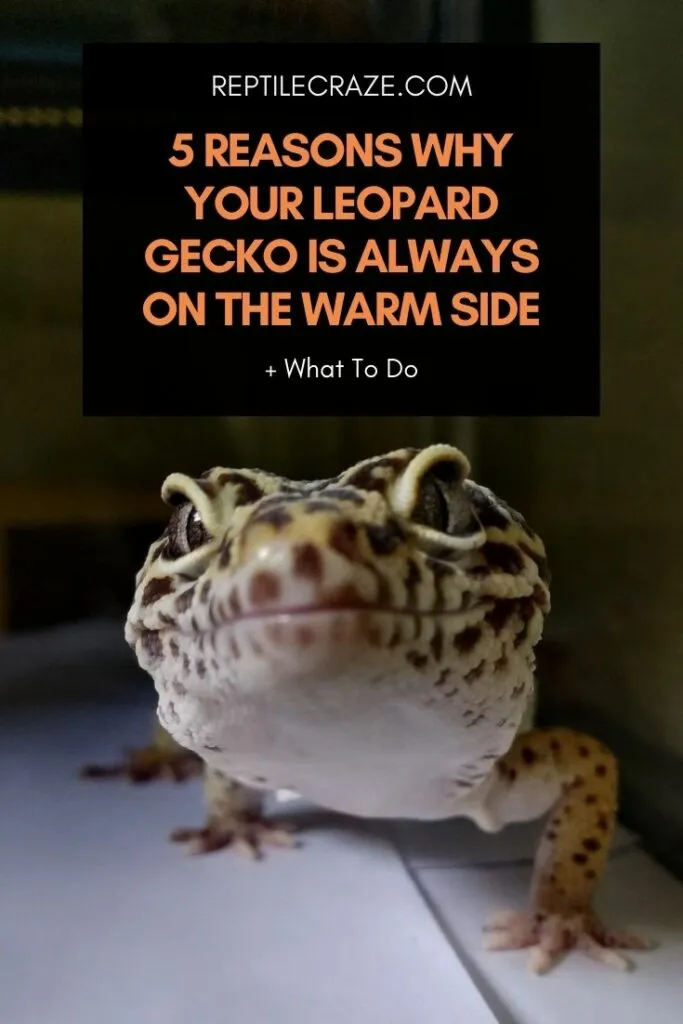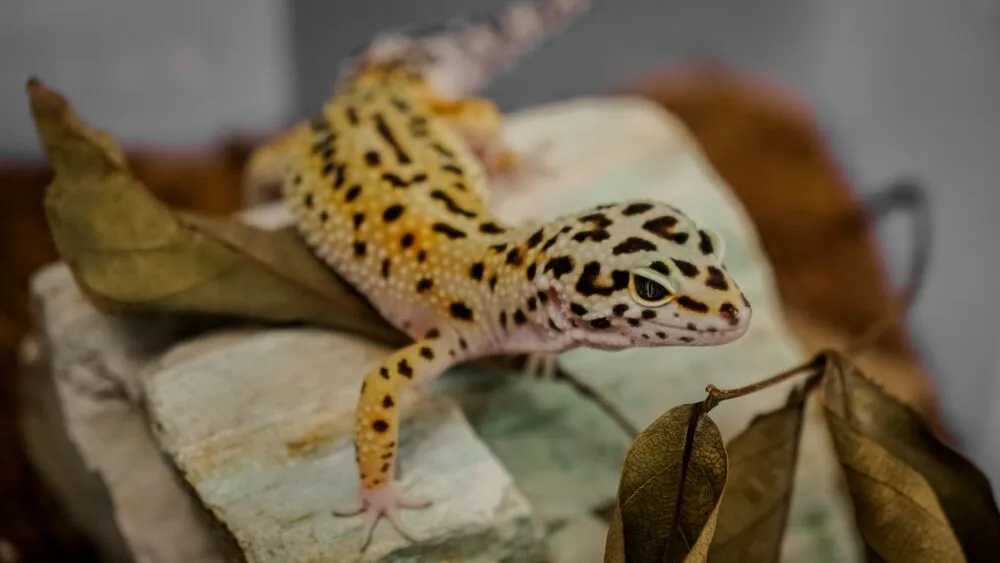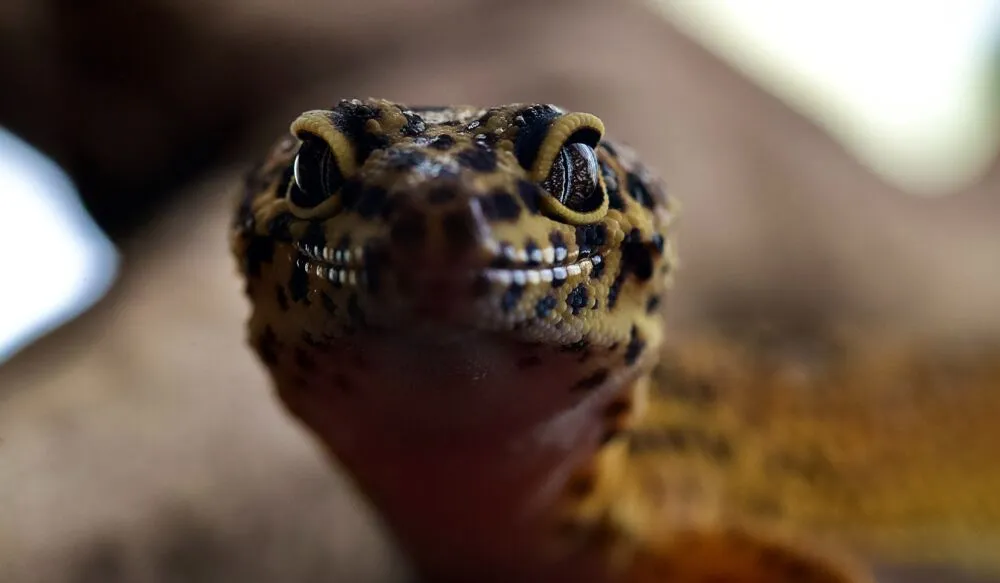
You walk by the
Leopard geckos that are always on the warm side of the
There’s much more to discover when it comes to knowing why your leopard gecko is always hanging out on the warm side of the
Table of Contents
5 Reasons Why Your Leopard Gecko Is Always On The Warm Side
First of all, it’s important to address the overall temperature of the
If these are too low in terms of temperature, the leopard gecko is going to do nothing except try to get warm (but it will never be warm enough). We’ve got you covered with correct temperature numbers later on in the article.
Also, stress is another reason they may not leave. It’s important for new owners to give their reptiles time to adjust. You can read more on that and learn how to help them feel safe in their new home.
Shedding can also be cause for staying where it’s warm. Also, asserting dominance is another reason why (and it’s why two leopard geckos shouldn’t be placed together in the same habitat).
Keep reading to get all these reasons explained to you in greater detail.
1. The Overall Temperature/Basking Spot Isn’t Correct
The number one reason leopard gecko owners report this behavior in their reptiles is because they haven’t correctly set the temps for the warm side and/or the basking spot.
The end result is a leopard gecko who is desperately trying to get and stay warm, but who will never feel that way because of the heat mat or basking lamp being too cool.
You can fix this. Make sure you have a thermometer on both the hot side and cool side. For your hot side, make sure it is between 80-85F. Your cool side should be 75-80F.
Basking areas are best kept at 90-100F. For a 20
It is a good idea to take temperatures regularly right at the basking spot, warm area, and cool area to ensure the equipment is working properly. We highly recommend using a temperature gun like this one as common (cheap) reptile thermometers can be way off.

2. Your Leopard Gecko Is Feeling Stressed Out
To be a leopard gecko can be quite stressful at times, believe it or not. These creatures are small and therefore at a disadvantage when it comes to certain predators. Leopard geckos are always on the defensive, and when they first meet you, it’s no different.
You mean well, and you are excited to take care of your leopard gecko. You’ve prepared all the materials needed for a great habitat, set up the
You’ve done hours of research and read forum after forum of reptile owners chatting about what to do when you first bring your leopard gecko home.
Even though you’ve done all the right things, you need to give your leopard gecko time to adjust.
Try to imagine what it’s like to be the gecko: You’re handled by the pet store owner or breeder, placed in a small box, shipped overnight, OR driven home in a car with sounds and stimuli you’ve never heard before, and introduced to a brand-new environment you’ve never seen before.
You probably would feel a bit scared too! So, it only makes sense you’d stay in a place that’s warm and reminds you of your native habitat.
If you are a new Leo owner and you’re reading this article, please give your gecko some time to adjust. Make sure you are giving them time to get used to their new digs. Keep it clean in there, and make sure the humidity and temperatures are appropriate.
In due time, your leopard gecko will be ready to come out and see you. Make sure you help your leopard gecko get comfortable by keeping a close eye on habitat conditions, feeding on a regular schedule, and interacting with them daily.
3. They’re Trying to Assert Dominance
Housing two male leopard geckos together is not a good idea. Females might be able to be kept together, but even that combination can be a bad one.
Your leopard gecko, if kept in a habitat with another Leo, might never come out of the warm hide because they might feel they’ll never be able to come back.
When it comes to two males, they can be territorial and are likely to fight one another. This leads to injuries, which inhibits your gecko’s ability to find
They could end up losing their tail or even end up dead as a result of the fighting.
Having two females together can be a safe combo, but you need to make sure you have a large enough
Leopard geckos need a 10-gallon
Size also matters- make sure that if one female is larger than the other, you keep them separated. Even with all this, we don’t recommend keeping two females together.
Males and females can be kept together, but for breeding purposes only. However, females put under the repeated stress of egg production will suffer a reduced lifespan, so do keep that in mind. When not breeding, males and females should be kept in separate tanks.
It’s best to keep your leopard gecko by themselves. They are not like other pets- dogs, for example- who do better as pack animals. In the wild, these creatures are solitude-seeking; they like being alone.
They get together to reproduce, and that’s about it. By not allowing the other leopard gecko into the warm hide, they jeopardize the health of that gecko- so don’t risk it.
4. They Are Shedding And Need Heat And Moisture
Your leopard gecko will go through his or her shed cycle as an adult just about once every 4-8 weeks. For young or juvenile Leos, you can expect weekly or fortnightly sheds.
To do this, they need plenty of moisture and lots of humidity, both of which are generally more prominent on the warm side of the habitat (warm moist hide, or water bowl on the warm side).
This behavior is normal and nothing to be concerned about, but new leopard gecko keepers might worry. However, learning what to expect with your reptile’s shed cycle will make the experience easier for both of you.
For starters, the shedding process may not be as noticeable in some morphs- Blizzard and Albinos experience a more understated shed as compared to other leopard geckos who change color from brown to white when welcoming their new skin.

Look out for certain behaviors in your leopard gecko that might indicate shedding. They may lose their appetites for a week before the shed.
They may rub onto rocks and
They also spend much more time in hiding, especially in moist hides. Shedding takes up to three days, give or take a day.
Some geckos can get their skins off in a matter of minutes, others can take the whole day to do it. Rest assured, it’s nothing to worry about.
5. The Cold Side Is Too Cold/Moist
Leopard geckos come from a climate that’s always warm, so when the cool side gets to be too cool- that is, anything under 75F, they tend to be wary of the cool zone.
Add in moisture to that cooler temp, and you have a recipe for a leopard gecko that wants nothing to do with that seemingly Arctic zone in their
After all, consider what happens when moisture and cold air meet. As temps get lower, the air is incapable of holding as much water as it could before. For us humans, this is how we get dry skin and chapped lips in the winter.
It’s sort of like that for your leopard gecko, too-since leopard geckos require moisture to thrive, this is one reason they might hang out on the warm side more often.
Your best bet is to make sure that the cool side is always 75-80F, and the humidity stays between 30% and 40%.
In Conclusion
Thank you for taking the time to learn about why your leopard gecko is hanging out on the warm side only. It can be alarming, but the fixes are relatively easy to implement.
Now, you can take steps to help your leopard gecko start enjoying the whole
- Enchi Ball Python: A Unique and Stunning Morph of Python regius - March 27, 2025
- Emerald Tree Monitor: The Enigmatic Green Guardian of the Rainforest - March 26, 2025
- The Egyptian Cobra (Naja haje): A Fascinating Serpent - March 25, 2025
